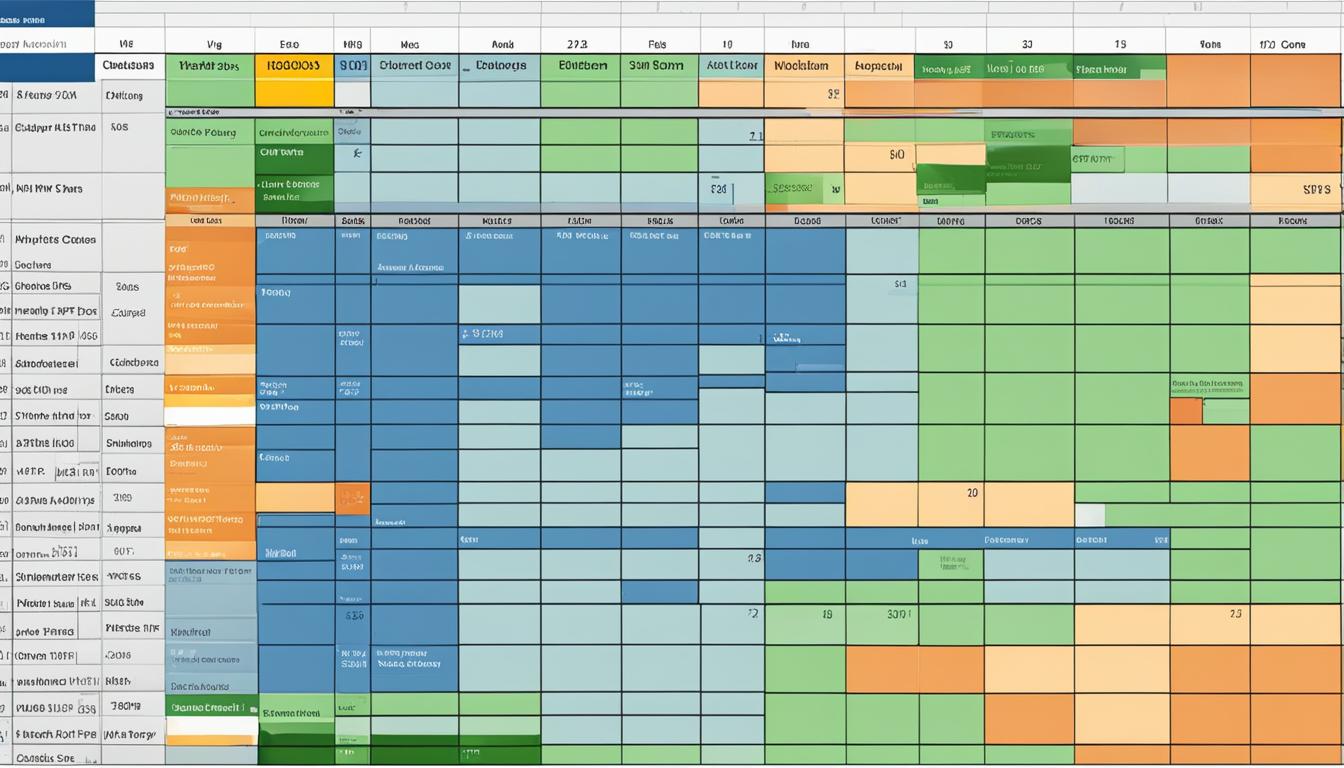Married Put: An Options Strategy For Hedging Risk

When it comes to managing risk in the stock market, married put options can be a valuable strategy to consider. This options strategy involves purchasing an at-the-money put option on a stock, providing downside protection against potential depreciation in its price. The married put allows investors to limit their potential losses while still participating in any price appreciation.
The cost of the put option can vary depending on factors such as the volatility of the underlying stock and the time until expiration. It is important to note that married put options are often used for low-volatility stocks or to hedge against specific downside risks. By understanding how to use married put options effectively, investors can enhance their risk management approach and protect their portfolios.
Key Takeaways:
- A married put options strategy involves purchasing an at-the-money put option on a stock to protect against depreciation in its price.
- Married put options allow investors to limit potential losses while still participating in price appreciation.
- The cost of the put option can vary depending on factors such as volatility and time until expiration.
- Married put options are often used for low-volatility stocks or to hedge against specific downside risks.
- Understanding how to use married put options effectively can enhance risk management and protect portfolios.
Understanding Married Put Options
Married put options are a versatile options trading strategy that allows investors to protect against downside risk while still participating in potential price appreciation. This strategy involves purchasing a put option on the same stock in which the investor holds a long position. The purpose of a married put is to create a floor under the stock’s price, limiting potential losses if the stock price drops. By understanding the mechanics of married put options, investors can effectively use this strategy to manage risk in their portfolios.
The mechanics of a married put involve buying the stock and the put option at the same time. This combination allows the investor to benefit from price appreciation while simultaneously having downside protection through the put option. The strike price of the put option serves as the floor for the stock’s price. If the stock price falls below the strike price, the investor can exercise the put option, selling the stock at the higher strike price to limit losses.
One of the main advantages of married put options is the ability to participate in potential price appreciation. If the stock price rises, the investor can still benefit from the increase in value. However, it is important to consider the cost of the put option. The premium paid for the put option reduces potential profits and must be factored into the overall investment strategy. Additionally, married put options are typically used for low-volatility stocks or to hedge against specific downside risks, so investors should assess whether this strategy aligns with their investment goals.

In summary, understanding married put options is essential for investors looking to protect against downside risk while maintaining the potential for price appreciation. By purchasing a put option on the same stock in which they hold a long position, investors can create a floor under the stock’s price and limit potential losses. The mechanics of married put options involve buying the stock and the put option simultaneously, with the strike price of the put option serving as the floor. It is important to consider the cost of the put option and whether this strategy aligns with investment goals and risk tolerance.
Implementing a Married Put Strategy
Implementing a married put strategy involves following a set of steps to ensure a successful trade. First, we need to identify a stock that we want to protect against potential downside risk. After selecting the stock, we should purchase an at-the-money put option with a strike price that provides an acceptable level of protection. It is important to note that the cost of the put option can vary depending on factors such as the volatility of the underlying stock and the time until expiration. Therefore, careful consideration should be given to choosing the appropriate put option.
Once we have identified the stock and purchased the put option, we need to buy the stock and the put option at the same time, creating a married put position. By doing this, we create a floor under the stock’s price, which is determined by the strike price of the put option. If the stock price drops below the strike price, we have the option to exercise the put option and sell the stock at the predetermined price, limiting our potential losses.
When implementing a married put strategy, it is crucial to consider the ideal conditions for using married put options. This strategy is often useful for low-volatility stocks or as a hedge against specific downside risks. It is also important to keep in mind that married put options are generally more effective during periods of low volatility or potential negative market events.
Step-by-Step Guide to Implementing a Married Put Option:
- Select a stock that you want to protect against potential downside risk.
- Purchase an at-the-money put option with a strike price that provides an acceptable level of protection.
- Buy the stock and the put option at the same time, creating a married put position.
- Monitor the stock’s price and exercise the put option if the stock price drops below the strike price.
By following this step-by-step guide, we can effectively implement a married put strategy and protect our investments against potential downside risk. It is important to remain vigilant and adjust our strategy as market conditions change to ensure the ongoing effectiveness of our risk management approach.

Analyzing the Outcome of a Married Put
When implementing a married put strategy, it is essential to analyze the potential outcome to assess its profitability and risk. By calculating key metrics such as maximum profit, determining the breakeven point, and estimating the maximum loss, investors can make informed decisions about their investment strategy.
Calculating Maximum Profit
The maximum profit for a married put strategy is reached when the stock price rises above the breakeven point. Unlike other strategies, the maximum profit is unlimited. This means that as the stock price continues to rise, the profits continue to increase. It is important to consider the premium paid for the put option when calculating the maximum profit.
Determining the Breakeven Point
The breakeven point is the price at which the stock needs to rise in order for the strategy to break even. It takes into account the premium paid for the put option. To determine the breakeven point, investors can use the following formula:
Breakeven Point = Stock Purchase Price + Put Option Premium
Estimating Maximum Loss
The maximum loss for a married put strategy is limited to the premium paid for the put option. This means that even if the stock price decreases significantly, the losses are capped at the premium paid. It is important to consider the cost of the put option when assessing the risk of the strategy.
| Metric | Calculation |
|---|---|
| Maximum Profit | Unlimited |
| Breakeven Point | Stock Purchase Price + Put Option Premium |
| Maximum Loss | Put Option Premium |
By evaluating these metrics, investors can gain insights into the potential profitability and risk of a married put strategy. It is important to consider these factors when making investment decisions and to regularly monitor and adjust the strategy to align with changing market conditions.
Comparing Married Puts with Other Strategies
When it comes to options trading strategies, married puts are just one of many options available to investors. Understanding how married puts compare to other strategies is essential for making informed investment decisions. Let’s explore the advantages and disadvantages of married puts and how they stack up against covered calls, as well as other similar strategies.
Advantages and Disadvantages of Married Puts
Married puts offer several advantages, such as downside protection and the ability to participate in price appreciation. By purchasing a put option, investors limit their potential losses in case the stock price drops. However, this protection comes at a cost, as the premium paid for the put option cuts into potential profits. Additionally, married puts are more suitable for short-term traders who are concerned with short-term price fluctuations, rather than long-term investors looking for steady growth.
Married Puts vs. Covered Calls
Married puts and covered calls are similar strategies that involve using options to manage risk. While married puts provide downside protection, covered calls generate income by selling call options on a stock already owned. Covered calls limit potential upside gains but still offer a level of protection. Choosing between these strategies depends on individual risk tolerance and investment goals.
Similar Strategies to Married Puts
There are several strategies similar to married puts that investors can consider for risk management. Protective puts, for example, involve buying a put option on an existing stock position to protect against downside risk. Collars are another option, involving buying a put option and selling a call option on the same stock to create a price range within which the stock can move. Each strategy has its own advantages and trade-offs, so it’s important to evaluate them in the context of your specific investment goals and market conditions.
| Advantages | Disadvantages | |
|---|---|---|
| Married Puts | Provides downside protection | Reduces potential profits |
| Covered Calls | Generates income | Limits potential upside gains |
| Protective Puts | Offers downside protection | Costs premium |
| Collars | Creates price range | Limits potential upside gains |
By considering the advantages and disadvantages of married puts and comparing them to other strategies, investors can make more informed decisions about their risk management approach. It’s essential to evaluate individual investment goals, risk tolerance, and market conditions before implementing any options strategy.
Differentiating a Married Put from a Protective Put
In options trading, a married put and a protective put are similar strategies with slight differences. Both strategies aim to provide downside protection for investors, but they differ in their execution and underlying rationale.
A married put involves buying the stock and the put option at the same time, while a protective put involves buying the put option after already owning the stock. The married put is considered a synthetic long call because it has the same profit potential as owning a call option without the stock. On the other hand, a protective put is a standalone strategy, providing downside protection for an existing stock position.
“A married put involves buying the stock and the put option at the same time, while a protective put involves buying the put option after already owning the stock.”
To illustrate the difference, let’s consider an example. Suppose an investor owns 100 shares of ABC stock, which is currently trading at $50 per share. The investor is concerned about a potential downturn in the stock price and wants to protect their investment. In this scenario, the investor could implement a married put strategy by purchasing 1 put option contract with a strike price of $50. This way, if the stock price drops below $50, the put option becomes profitable and offsets the losses in the stock position.
In contrast, if the investor already owns the 100 shares of ABC stock and decides to buy a put option with a strike price of $50, they would be implementing a protective put strategy. The put option provides downside protection in case the stock price declines, but it is not part of an initial investment strategy like the married put.
| Key Differences | Married Put | Protective Put |
|---|---|---|
| Timing of Purchases | Simultaneous purchase of stock and put option | Put option purchased after owning the stock |
| Profit Potential | Similar to owning a call option | Limited to the stock’s price appreciation |
| Strategy Type | Part of an initial investment strategy | Standalone strategy |
Understanding the differences between a married put and a protective put can help investors choose the most suitable approach for their risk management and investment goals.

The Benefits and Risks of Married Put Options
Married put options offer several benefits for investors seeking to hedge against downside risk in the stock market. One of the key advantages of this strategy is the ability to limit potential losses while still participating in price appreciation. By purchasing an at-the-money put option on a stock, investors create a floor under its price, protecting against depreciation. This downside protection provides investors with peace of mind during market downturns, reducing the risk of significant losses.
Another benefit of married put options is their flexibility. Investors can choose different strike prices for the put option, allowing them to customize the level of protection based on their risk tolerance and the specific downside risks they wish to hedge against. This flexibility makes married put options a versatile tool for risk management in different market conditions.
However, it is important to weigh the benefits against the disadvantages and risks associated with married put options. One significant disadvantage is the cost of the put option. Purchasing the option comes with a premium, which reduces the potential profits of the overall investment. Additionally, married put options may not be suitable for long-term investors who are not concerned with short-term price fluctuations. The strategy is more commonly used by active traders and investors who are looking to manage risk and protect their portfolios in the short to medium term.
Furthermore, married put options may not be appropriate for all market conditions and stocks. The strategy is particularly effective for low-volatility stocks or when investors anticipate potential negative market events. Careful consideration of market conditions and individual stock characteristics is essential before implementing a married put strategy.
| Benefits of Married Put Options | Disadvantages and Risks of Married Put Options |
|---|---|
|
|
Overall, married put options can be a valuable tool for investors seeking to hedge against downside risk in the stock market. However, it is important to carefully evaluate the advantages and disadvantages before implementing this strategy. By considering the specific benefits, risks, and suitability for individual stocks and market conditions, investors can make informed decisions and tailor their risk management approach to their own investment goals.
Exploring Alternatives to Married Put Options
While married put options can be an effective hedging strategy, there are other types of options that investors can consider for risk management in the stock market. By diversifying their risk management toolkit, investors can enhance their ability to navigate market fluctuations and protect their portfolios. Some alternatives to married put options include:
- Collar Strategies: This strategy involves buying a put option to protect against downside risk and selling a call option to generate income. The put option provides a floor for the stock’s price, while the call option limits potential upside gains.
- Long Straddles: With this strategy, investors buy both a put option and a call option on the same stock, anticipating significant price movements. If the stock price moves significantly higher or lower, the investor can profit from either direction.
“Collar strategies involve buying a put option to protect against downside risk and selling a call option to generate income.”
Each of these strategies has its own advantages and disadvantages, and the choice depends on an investor’s risk tolerance, market outlook, and investment goals. While married put options provide a straightforward approach to hedging, collar strategies and long straddles offer more flexibility and potential for higher returns. However, they may also introduce additional complexity and cost.
| Strategy | Advantages | Disadvantages |
|---|---|---|
| Married Put Options | Simple and straightforward | Cost of the put option reduces potential profits |
| Collar Strategies | Provides downside protection and generates income | Limits potential upside gains |
| Long Straddles | Potential for profit in either direction | Higher complexity and cost |
“Collar strategies provide downside protection and generate income, but they limit potential upside gains.”
By considering these alternative options strategies, investors can build a diversified risk management approach that aligns with their individual preferences and objectives. It is crucial to thoroughly evaluate each strategy’s advantages, disadvantages, and suitability for specific market conditions before incorporating them into an investment portfolio.

Understanding Married Puts in Context
To fully comprehend the benefits and applications of married put options, let’s dive into an example that illustrates how this strategy works. Imagine you own 100 shares of XYZ stock, which is currently trading at $50 per share. Concerned about a potential decline in the stock’s value, you decide to implement a married put strategy to hedge against market risk.
First, you purchase an at-the-money put option with a strike price of $50, which expires in three months. This put option gives you the right to sell your 100 shares of XYZ stock at the strike price of $50, regardless of how low the stock price may drop. The cost of the put option is $3 per share, totaling $300.
Now, let’s consider different scenarios and how the married put strategy would work in each case:
- If XYZ stock price remains stable or increases: In this scenario, the value of your stock position may appreciate, allowing you to benefit from price appreciation. The put option would expire worthless, as there would be no need to exercise it.
- If XYZ stock price declines moderately: If the stock price drops to $45 per share, for example, your put option provides downside protection. You can choose to exercise the put option and sell your 100 shares at the strike price of $50, limiting your loss to $5 per share.
- If XYZ stock price plummets: In the worst-case scenario, if the stock price falls to $40 per share, you can still exercise the put option and sell your shares at the strike price of $50, limiting your loss to $5 per share plus the cost of the put option.
By using a married put strategy, you have effectively created a floor under the stock’s price, limiting your potential losses while still participating in any price appreciation. This approach allows you to hedge against market risk, providing a level of insurance for your investment portfolio.
Example: XYZ Stock Married Put Strategy
| Scenario | XYZ Stock Price | Profit/Loss on Stock Position | Profit/Loss on Put Option | Total Profit/Loss |
|---|---|---|---|---|
| Stable or Increase | $50+ | +$0 | -$300 | -$300 |
| Moderate Decline | $45 | -$5 per share | +$0 | -$5 per share |
| Significant Decline | $40 | -$10 per share | +$10 per share | +$0 |

Conclusion
In conclusion, married put options are a valuable strategy for hedging against downside risk in the stock market. They provide investors with the ability to limit potential losses while still participating in price appreciation. By understanding the mechanics of married put options, investors can effectively implement this strategy and assess their outcomes. It is important to carefully evaluate the benefits and risks of married puts and consider alternatives to create a well-rounded risk management approach.
Married put options offer several advantages, such as downside protection and reduced risk during market downturns. However, there are also some disadvantages, including the cost of the put option and potential limitations on upside gains. It is crucial to consider an investor’s risk tolerance, investment goals, and market conditions when choosing between different options strategies.
While married put options can be a powerful tool for risk management, it is essential to expand your risk management toolkit. Exploring other types of options, such as protective puts, collars, and long straddles, can provide additional strategies to mitigate risk in the stock market. By diversifying your risk management approach, you can adapt to different market conditions and enhance your ability to navigate the ever-changing landscape of the stock market.
FAQ
What is a married put strategy?
A married put strategy involves purchasing an at-the-money put option on a stock to protect against depreciation in its price. It allows investors to limit their potential losses while still participating in any price appreciation.
How does a married put strategy work?
The strategy involves buying the stock and the put option at the same time, creating a floor under the stock’s price. This floor is determined by the strike price of the put option. If the stock price drops below the strike price, the investor can exercise the put option for downside protection.
When should I consider using a married put strategy?
Married put options are often used for low-volatility stocks or to hedge against specific downside risks. It is important to consider the ideal conditions for using married put options, such as low volatility and potential negative market events.
How do I implement a married put strategy?
To implement a married put strategy, you should identify a stock that you want to protect against potential downside risk. Purchase an at-the-money put option with a strike price that provides an acceptable level of protection. Buy the stock and the put option at the same time, creating a married put position.
What factors should I consider when analyzing the outcome of a married put?
When analyzing the outcome of a married put, you should calculate key metrics such as maximum profit, breakeven point, and maximum loss. Maximum profit is reached when the stock price rises above the breakeven point, while maximum loss is limited to the premium paid for the put option.
How does a married put compare to other options strategies?
Compared to covered calls, married puts provide more downside protection but limit potential upside gains. Similar strategies to married puts include protective puts and collars. It is important to consider your risk tolerance, investment goals, and market conditions when choosing between different options strategies.
What is the difference between a married put and a protective put?
A married put involves buying the stock and the put option at the same time, while a protective put involves buying the put option after already owning the stock. A married put is considered a synthetic long call, while a protective put is a standalone strategy providing downside protection for an existing stock position.
What are the benefits of using a married put strategy?
Married puts offer several benefits, such as downside protection, the ability to participate in price appreciation, and reduced risk during market downturns. They provide investors with peace of mind and a level of insurance against unexpected negative events.
Are there any risks or disadvantages to using a married put strategy?
The cost of the put option can be significant and reduces potential profits. Married puts may not be appropriate for long-term investors who are not concerned with short-term price fluctuations. They may also not be suitable for all market conditions and stocks. Thorough evaluation of the advantages and disadvantages is necessary before implementing a married put strategy.
Are there alternatives to married put options for risk management?
Yes, there are alternatives such as collar strategies, which involve buying a put option and selling a call option on the same stock, and long straddles, which involve buying both a put option and a call option on the same stock. Each strategy has its own advantages and disadvantages, and investors should evaluate their risk tolerance and investment goals before choosing an alternative to married put options.
How can married put options be used in context?
Married put options can be used to hedge against market risk by protecting a portfolio against potential downturns. They provide investors with the opportunity to limit potential losses while still participating in price appreciation. Understanding the mechanics and practical applications of married puts can empower investors to make informed decisions about their risk management strategies.
How can I expand my risk management toolkit?
It is essential to diversify risk management strategies. Other types of options, such as protective puts, collars, and long straddles, can be used in combination with married puts to create a comprehensive risk management toolkit. By adding a variety of options strategies to their repertoire, investors can tailor their risk management approach to different market conditions and investment goals.







